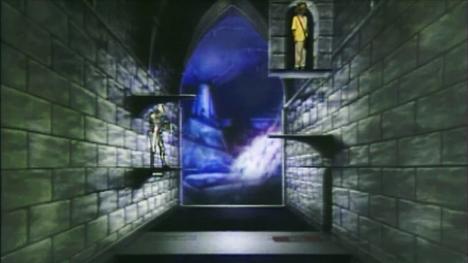Le Chevalier du Labyrinthe was a French adaptation of Knightmare. It was produced by an independent television company (Marina Productions) and broadcast on Antenne 2.
Le Chevalier du Labyrinthe ran from September 1990 on a weekly basis for two series. Over 100 episodes were made, and it is still fondly remembered by French viewers.
Introduction
(Derived from the French production press pack.)
One of the four players becomes the 'Knight of the Labyrinth'. He or she is assisted in his quest by three friends as they navigate rooms of the castle.
With the help of the advisors and the Master, the knight must solve riddles, answer questions, avoid traps, cross narrow passages, and face strange creatures.
If the knight perishes, it is replaced by one of the advisors. If three knights are eliminated, the team loses the game.
To complete the game, the players must be attentive and record everything they hear. The knowledge they accumulate will allow them to reach the final stage and claim their prize.

Gameplay
In the first series, quests began in the dice room, as in Knightmare Series 3. Many of the rooms, traps and hazards were familiar from the 1989 series.
Inside the labyrinth, the first principal goal was to reach Merlin's chamber. The knight crossed the void to summon Merlin by answering questions from Morganne la Fée.
Merlin assessed what the team had learnt during their quest (including answers they had not known in earlier rooms). Once he was satisfied, the knight sat on his throne and was transported to the treasure room for the final challenge.
The knight removes the helmet before solving a puzzle on the table (against the clock in the second series). If the knight succeeds, he/she is able to draw a sword from a stone, revealing the prizes.

The Labyrinth
Three locations were purpose-built: the castle antechamber, a balcony for the advisors, and the final treasure zone (salle du trésor).
Most of the gameplay rooms were based on David Rowe's artwork for Series 3 (1989), using chromakey and an Amiga 2000 for effects.
Some of David's illustrations were adapted slightly to introduce a different obstacle. By the second series, new and unseen rooms had been commissioned.
As teams had numerous 'lives', the average difficulty level was higher. Some rooms that featured often in Chevalier were rarely seen on Knightmare.
Knights were often made to attempt rooms in a different way to Knightmare. This emphasised the reuse of stock footage, such as goblin pursuits in the Stalactite Caves.

Characters
Le Chevalier du Labyrinthe had a much smaller cast then Knightmare (as few as five), and therefore a smaller range of characters. Most of the cast played several characters.
Some of these had clear parallels to Knightmare, such as Merlin (like-for-like), Velda (like-for-like), Bouffon (Motley), Mandragore (Mildred), and a talking raven, Tarok.
Others were more original, including Morgane la Fée (a fairy), and the underworld spectre of Tados, who inhabited the cave usually associated with Cedric the Mad Monk.
The actors are considered legends in France and are well-known through other roles in television and film. The 'Master of the Castle', Georges Beller, is particularly eminent in France as a host and entertainer.

Sponsored by SEGA / Virgin Leisure
The show was initially sponsored by SEGA, the market leader in Europe for gaming consoles in 1990. Winners during the first series received a SEGA Master System. The production press pack explains:
Le Chavalier du Labyrinthe reflects young people's passion for adventures and video games. Like the show, the SEGA Master System transports games players into an imaginary world.
The SEGA Master System is a high-tech console for television. Priced at 690F, showing the calibre of the prize, the SEGA console has a catalogue of over 100 games.
SEGA also contributes to the generic tape announcements of Le Chavalier du Labyrinthe.



